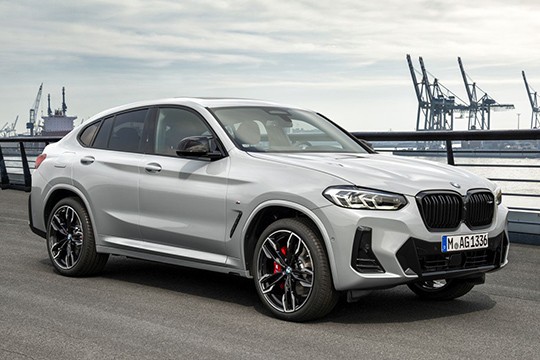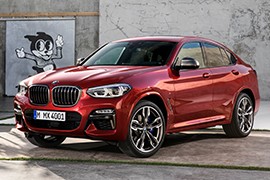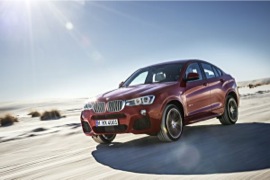BMW X4 Models/Series Timeline, Specifications & Photos
First production year: 2014
Engines: Mild hybrid diesel, Mild hybrid, Diesel, Gasoline
Body style: SUV (Sports Utility Vehicle)
BMW introduced a facelifted version for the X4 just three years after introducing the second-generation's model.
After successfully revolutionizing the automotive industry with the SAV-Coupe X6, BMW introduced a smaller brother named X4, which appeared in 2014. In 2018, the carmaker introduced a second-generation for it and then refreshed it in 2021. Thus, it matched the exact timetable with the other compact-sized SAV (Sport Activity Vehicle), the X3. Both vehicles shared the same CLAR (Cluster Architecture) platform with their bigger brother X5 and other sedans.
BMW introduced a new front bumper design with a single section frame kidney-grille adorned by a mesh design. Its adaptive Matrix LED headlights were standard and flattered by 10 mm (0.4") than on the non-facelifted version. On the sides, all versions came fitted as standard with specific side-sills, finished in light gray. At the back, the X4 featured LED taillights with a 3D design and horizontal lines to emphasize the car's width. The apron sported wide free-form tailpipe trims.
Inside, BMW installed a 10.25" wide format infotainment screen above the center stack, with an option for a 12.3" display, in the same free-floating look. All versions featured a three-zone automatic climate control for more comfort on the rear seats. The redesigned center console featured a new shape for the gear-selector and the iDrive's rotary knob.
Under the hood, the most significant upgrade was the electrification, which brought a new 48-volt system. All engines showed better fuel efficiency. Apart from vehicles fitted with internal combustion engines only, the carmaker also installed a plug-in hybrid drivetrain in the X4.
BMW X4 M40d 48V 8AT AWD (340 HP)
The second generation of the BMW X4 was revealed in 2018 and brought a refreshed design, as well as new features.
The front of the car looked very similar to the one of the previous X4, however, the small differences made it look even more aggressive and modern, like the bigger front grille with a 3D look.
The back of the car looked completely new, with its new taillights that were used on the BMW 8-Series and 3-Series being placed at the extreme edges.
While the X4 had a high loading lid, once inside, the cargo area offered 525 liters. What’s more, the rear seats were foldable and the space could increase considerably.
Opening the trunk lid was easier by pressing the BMW Logo instead of the old fashioned way we were used with.
The practical sports coupe had improved driving dynamics, having a double wishbone setup, a widened rear track and a perfect 50-50 front to rear distribution.
The ride height was lowered, thus the X4 had a lower center of gravity. The car could easily take turns at high speeds with its astonishing degree of handling.
Users could choose between from the standard model of 190 hp to the top of the range, the 354 hp M40i.
The interior was made with great to touch materials, visually very modern with its virtual digital cockpit technology developed by BMW. The seats were very comfortable and offered great support.
The passengers in the back though should not be very tall, as the roof line is low. The middle seat could only accommodate a child if comfort was desired.
BMW X4 20d xDrive 8AT (190 HP)
After the success it recorded with the X6 SAC (Sports Activity Coupe), BMW decided to create a smaller sibling for it, a sporty-looking version of the already-known X3.
The era of SUV-coupe vehicles was made famous by the X6, and other automakers struggled for more than a decade to catch up with it. But the German automaker had another product ready for the marker: the X4. Thus, in 2014, it unveiled the new vehicle at the New York International Auto Show. While it wasn't the roomiest SUV on the market, it was unique in its shape and backed up by BMW's powerful engines.
BMW made the X4 with a front fascia that resembled the X3 but with a different lower apron. The large kidney grille between the headlights sported vertical slats, and on the lower bumper, it included additional air intakes that cooled the brakes. From its profile, the sloped-down roof ended with a small deck behind the rear windscreen.
BMW installed a pair of bolstered seats at the front, separated by a tall and wide center console. In front of the driver, the automaker placed the instrument cluster filled with analog dials and a display for the onboard computer. A head-up display was also on the options list. In the back, the 40:20:40 split-folding bench was wide enough for three adults, with an almost flat center tunnel that crossed the car from front to back.
Depending on the market, BMW installed a choice of gasoline or diesel engines, most of them being turbocharged. The standard gearbox for most of the range was a six-speed manual, while an eight-speed automatic was on the options list.


